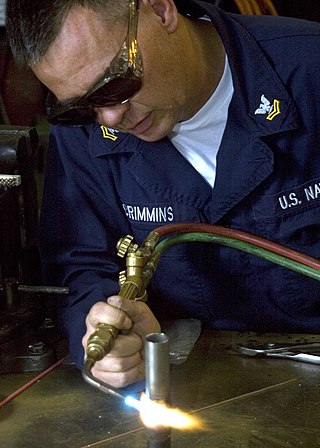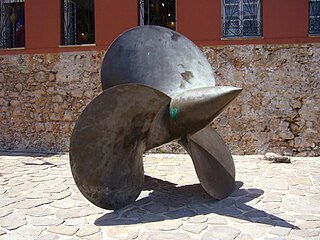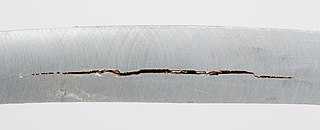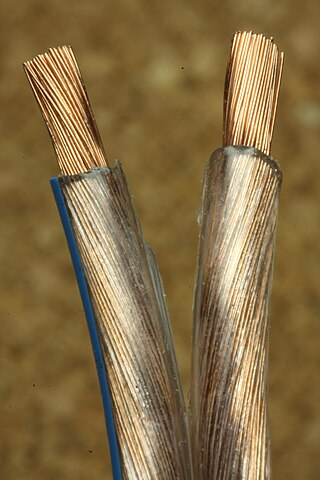
Solder is a fusible metal alloy used to create a permanent bond between metal workpieces. Solder is melted in order to wet the parts of the joint, where it adheres to and connects the pieces after cooling. Metals or alloys suitable for use as solder should have a lower melting point than the pieces to be joined. The solder should also be resistant to oxidative and corrosive effects that would degrade the joint over time. Solder used in making electrical connections also needs to have favorable electrical characteristics.
Beryllium copper (BeCu), also known as copper beryllium (CuBe), beryllium bronze, and spring copper, is a copper alloy with 0.5–3% beryllium. Copper beryllium alloys are often used because of their high strength and good conductivity of both heat and electricity. It is used for its ductility, weldability in metalworking, and machining properties. It has many specialized applications in tools for hazardous environments, musical instruments, precision measurement devices, bullets, and some uses in the field of aerospace. Beryllium copper and other beryllium alloys are harmful carcinogens that present a toxic inhalation hazard during manufacturing.

Cupronickel or copper–nickel (CuNi) is an alloy of copper with nickel, usually along with small quantities of other metals added for strength, such as iron and manganese. The copper content typically varies from 60 to 90 percent.

In physics and electrical engineering, a conductor is an object or type of material that allows the flow of charge in one or more directions. Materials made of metal are common electrical conductors. The flow of negatively charged electrons generates electric current, positively charged holes, and positive or negative ions in some cases.

Brazing is a metal-joining process in which two or more metal items are joined by melting and flowing a filler metal into the joint, with the filler metal having a lower melting point than the adjoining metal.

Phosphor bronze is a member of the family of copper alloys. It is composed of copper that is alloyed with 0.5–11% of tin and 0.01–0.35% phosphorus, and may contain other elements to confer specific properties. The tin increases the corrosion resistance and strength of the alloy, while the phosphorus increases its wear resistance and stiffness.

Hydrogen embrittlement (HE), also known as hydrogen-assisted cracking or hydrogen-induced cracking (HIC), is a reduction in the ductility of a metal due to absorbed hydrogen. Hydrogen atoms are small and can permeate solid metals. Once absorbed, hydrogen lowers the stress required for cracks in the metal to initiate and propagate, resulting in embrittlement. Hydrogen embrittlement occurs in steels, as well as in iron, nickel, titanium, cobalt, and their alloys. Copper, aluminium, and stainless steels are less susceptible to hydrogen embrittlement.

Glass-to-metal seals are a type of mechanical seal which joins glass and metal surfaces. They are very important elements in the construction of vacuum tubes, electric discharge tubes, incandescent light bulbs, glass-encapsulated semiconductor diodes, reed switches, glass windows in metal cases, and metal or ceramic packages of electronic components.
C41100 Lubaloy is a wrought copper alloy that is composed mainly of copper and zinc. Lubaloy possesses many favorable characteristics making it, and other types of brass, a popular choice in manufacturing. It is a source material in many processes including the creation of electrical components and bullet-making. There are both positive and negative health effects that are associated with the use of this material.
Incoloy refers to a range of superalloys now produced by the Special Metals Corporation (SMC) group of companies and created with a trademark by the Inco company in 1952. Originally Inco protected these alloys by patent. In 2000, the SMC published a 61-page document entitled "High-Performance Alloys for Resistance to Aqueous Corrosion" highlighting Incoloy, as well as Monel and Inconel products, and their use in fluid environments such as sulfuric acid, hydrochloric acid, hydrofluoric acid, phosphoric acid, nitric acid, other acids as well as freshwater environments.

Copper has been used in electrical wiring since the invention of the electromagnet and the telegraph in the 1820s. The invention of the telephone in 1876 created further demand for copper wire as an electrical conductor.
2014 aluminium alloy (aluminum) is an aluminium-based alloy often used in the aerospace industry.
1050 aluminium alloy is an aluminium-based alloy in the "commercially pure" wrought family. As a wrought alloy, it is not used in castings. Instead, it is usually formed by extrusion or rolling. It is commonly used in the electrical and chemical industries, on account of having high electrical conductivity, corrosion resistance, and workability. 1050 alloy is also sometimes used for the manufacture of heat sinks, since it has a higher thermal conductivity than other alloys. It has low mechanical strength compared to more significantly alloyed metals. It can be strengthened by cold working, but not by heat treatment.
1060 aluminium alloy is an aluminium-based alloy in the "commercially pure" wrought family. It is fundamentally very similar to 1050 aluminium alloy, with the difference coming down to 0.1% aluminium by weight. However, while both 1050 and 1060 are covered by the same ISO standard, they are covered by different ASTM standards.
5154 aluminium alloy is an alloy in the wrought aluminium-magnesium family. As an aluminium-magnesium alloy, it combines moderate-to-high strength with excellent weldability. 5154 aluminium is commonly used in welded structures such as pressure vessels and ships. As a wrought alloy, it can be formed by rolling, extrusion, and forging, but not casting. It can be cold worked to produce tempers with a higher strength but a lower ductility. It is generally not clad.
5454 aluminium–magnesium alloy is an alloy in the wrought aluminium-magnesium family. It is closely related to 5154 aluminium alloy. As an aluminium-magnesium alloy, it combines moderate-to-high strength with excellent weldability. Like 5154, 5454 aluminium is commonly used in welded structures such as pressure vessels and ships. As a wrought alloy, it can be formed by rolling, extrusion, and forging, but not casting. It can be cold worked to produce tempers with a higher strength but a lower ductility. It is generally not clad.
5456 aluminium–magnesium alloy is an alloy in the wrought aluminium-magnesium family. While it is closely related to 5356 aluminium alloy, it is used in structural applications, like most other aluminium-magnesium alloys, and not as filler for welding. As a wrought alloy, it can be formed by rolling, extrusion, and forging, but not casting. It can be cold worked to produce tempers with a higher strength but a lower ductility. It is susceptible to exfoliation corrosion when held at temperatures above 65 °C (150 °F) for extended periods of time.
6005A aluminium alloy is an alloy in the wrought aluminium-magnesium-silicon family. It is closely related, but not identical, to 6005 aluminium alloy. Between those two alloys, 6005A is more heavily alloyed, but the difference does not make a marked impact on material properties. It can be formed by extrusion, forging or rolling, but as a wrought alloy it is not used in casting. It cannot be work hardened, but is commonly heat treated to produce tempers with a higher strength at the expense of ductility.
6262 aluminium alloy is an alloy in the wrought aluminium-magnesium-silicon family. It is related to 6162 aluminium alloy, but sees much more widespread use. It is notably distinct from 6162, and most other aluminium alloys, in that it contains lead in its alloy composition. It is typically formed by extrusion, forging, or rolling, but as a wrought alloy it is not used in casting. It can also be clad, but that is not common practice with this alloy. It cannot be work hardened, but is commonly heat treated to produce tempers with a higher strength but lower ductility.
The International Annealed Copper Standard (IACS) is a standard established in 1914 by the United States Department of Commerce. It is an empirically derived standard value for the electrical conductivity of commercially available copper.








